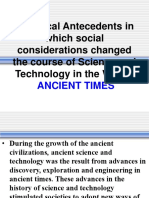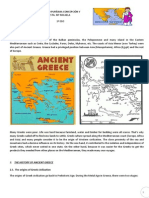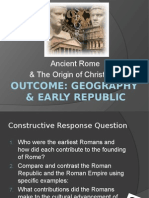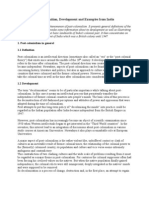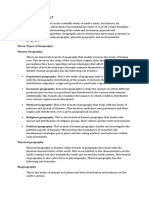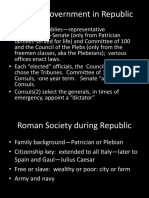0 ratings0% found this document useful (0 votes)
166 viewsRoman Civilization
Roman Civilization
Uploaded by
FactPaloozaRandom and neat facts about Roman Civilization. That can also be found on http://www.FactPalooza.Com Along with many other cool and interesting random facts.
Copyright:
Attribution Non-Commercial (BY-NC)
Available Formats
Download as DOCX, PDF, TXT or read online from Scribd
Roman Civilization
Roman Civilization
Uploaded by
FactPalooza0 ratings0% found this document useful (0 votes)
166 views2 pagesRandom and neat facts about Roman Civilization. That can also be found on http://www.FactPalooza.Com Along with many other cool and interesting random facts.
Copyright
© Attribution Non-Commercial (BY-NC)
Available Formats
DOCX, PDF, TXT or read online from Scribd
Share this document
Did you find this document useful?
Is this content inappropriate?
Random and neat facts about Roman Civilization. That can also be found on http://www.FactPalooza.Com Along with many other cool and interesting random facts.
Copyright:
Attribution Non-Commercial (BY-NC)
Available Formats
Download as DOCX, PDF, TXT or read online from Scribd
Download as docx, pdf, or txt
0 ratings0% found this document useful (0 votes)
166 views2 pagesRoman Civilization
Roman Civilization
Uploaded by
FactPaloozaRandom and neat facts about Roman Civilization. That can also be found on http://www.FactPalooza.Com Along with many other cool and interesting random facts.
Copyright:
Attribution Non-Commercial (BY-NC)
Available Formats
Download as DOCX, PDF, TXT or read online from Scribd
Download as docx, pdf, or txt
You are on page 1of 2
Roman Civilization
• It became one of the largest empires in the ancient world.
• Ancient Rome was a civilization that grew out of a small agricultural
community founded on the Italian Peninsula as early as the 10th century BC.
• Roman civilization shifted from a monarchy to an oligarchic republic to an
increasingly autocratic empire.
• The Roman civilization started along the Tiber River, in the west of Italy
• Ancient Rome commanded a vast area of land, with tremendous natural
and human resources.
• Roman civilization is often grouped into "classical antiquity" with ancient
Greece, a civilization that inspired much of the culture of ancient Rome.
• Ancient Rome contributed greatly to the development
of law, war, art, literature, architecture, technology, religion,
and language in the Western world, and its history continues to have a major
influence on the world today.
• With the rise of the Roman political power the Latin language became
popular.
• Roman society is largely viewed as hierarchical, with slaves (servi) at the
bottom, freedmen (liberti) above them, and free-born citizens (cives) at the
top.
• The primary aim of education during this period was to train young men
in agriculture, warfare, Roman traditions, and public affairs.
• Sometime around 1st millennium BC some other tribe, probably from the
eastern Mediterranean side, came and settled in Etruria (now Toscana or
Tuscany) on the northwestern side of the river Tiber and These people were
called the Etruscans.
• They promoted trade and gave the idea of the citizen assembly. Under
their rule, Rome grew into a prosperous city.
• Portrait sculpture during the period utilized youthful and classical
proportions, evolving later into a mixture of realism and idealism.
• The Romans expanded their empire, gained full control over the
Mediterranean coasts up to Spain, and conquered Greece and Macedonia by
140 BC.
• Julius Caesar became the sole ruler of the Roman Empire by pushing off
the others; but he was assassinated by a group of Republican aristocrats in
44 BC.
• Octavian (heir of Julius Caesar) took over the reign with the alliance of two
more army officers including Mark Anthony who fell in love with Cleopatra
(the Queen of Egypt).
• The Roman Empire reached its height between 100 to 180 AD in power and
prosperity and all of the neighboring countries of the Mediterranean
including Jerusalem were under its regime.
• There was a period of chaos in the emperorship between 235 to 286 AD
when any powerful person or officer could seize the power by force and
overthrow his rival.
• Roman Empire was split into two sections, Eastern and Western, with
separate emperorships For the convenience of administration the.
• They also introduced a calendar around 738 BC that had only 10 months in
a year, and a year had only 304 days.
• In 80 AD, they built a four story open amphitheater in Rome with a 50,000
seating capacity, called the Colosseum.
• Before 300 AD, in the Roman empire, most of the people worshipped a
number of traditional gods and goddesses like: Jupiter, Juno, Pluto, Bacchus,
Diana and Venus, etc.
• In 313 AD Constantine I accepted the Christian religion and since then
Christianity flourished.
• When Theodosius died in 395 AD, the Roman Empire was permanently split
into two Empires, East and West, and Christianity was accepted as their state
religion.
• Thus, in 509 BC the Romans took over the rule of Rome by throwing out
the last king of the Etruscans and started the Roman Republic
You might also like
- How It Was in Reality FomenkoDocument868 pagesHow It Was in Reality FomenkoSean Griffin100% (3)
- Ubuntu Contribution Book FCDocument362 pagesUbuntu Contribution Book FCArtemisLogic93% (15)
- The Progressive Era WorksheetDocument3 pagesThe Progressive Era Worksheetapi-298884028No ratings yet
- Foundation of Civilization World History Lec 1Document13 pagesFoundation of Civilization World History Lec 1alabangcollege100% (1)
- 30 Years War WebquestDocument3 pages30 Years War Webquestapi-311017794100% (1)
- The Roman Civilization: Lecture Notes Prepared by Rev. Dr. B. Mungai May-August Semester 2020Document13 pagesThe Roman Civilization: Lecture Notes Prepared by Rev. Dr. B. Mungai May-August Semester 2020Wallace Ngugi100% (1)
- Brief Introduction of Political History of BangladeshDocument12 pagesBrief Introduction of Political History of BangladeshChaudhary Muhammad Ali100% (1)
- The Amazing Discovery of The Bust of NefertitiDocument4 pagesThe Amazing Discovery of The Bust of Nefertitibenmorales100% (1)
- Ancient Historical AntecedentsDocument43 pagesAncient Historical Antecedentsjoan7casillano7teger100% (1)
- Reclaiming A Plundered Past: Archaeology and Nation Building in Modern Iraq - Magnus Thorkell BernhardssonDocument3 pagesReclaiming A Plundered Past: Archaeology and Nation Building in Modern Iraq - Magnus Thorkell BernhardssonShamsiNinurtaNo ratings yet
- The Dawn of Civilization: Earliest Times To 700 B.C. Editors A.H. Dani and V.M. MassonDocument516 pagesThe Dawn of Civilization: Earliest Times To 700 B.C. Editors A.H. Dani and V.M. MassonAhmed Ikram100% (3)
- Greek CivilizationDocument2 pagesGreek CivilizationMuhammad AiNo ratings yet
- "Ancient Inca Civilization" Category Description 1. Political SystemDocument8 pages"Ancient Inca Civilization" Category Description 1. Political SystemshaiNo ratings yet
- ch6 2Document6 pagesch6 2Djordje KrsmanovicNo ratings yet
- Roman EmpireDocument6 pagesRoman Empirezouz3000No ratings yet
- British Imperialism in India QuizDocument2 pagesBritish Imperialism in India QuizJustin HsuNo ratings yet
- Greek Civilization Aegean Sea & Greek Mainland - Are Regarded As TheDocument2 pagesGreek Civilization Aegean Sea & Greek Mainland - Are Regarded As TheMyraNo ratings yet
- G-8 Greek CivilizationDocument25 pagesG-8 Greek CivilizationAbigail Ranque-DiaNo ratings yet
- Answer Key - Annual Examination Revision Worksheet - 1 Lessons 1,2&3Document4 pagesAnswer Key - Annual Examination Revision Worksheet - 1 Lessons 1,2&3JazzTGB145No ratings yet
- Economic System - Meaning and TypesDocument3 pagesEconomic System - Meaning and TypesM HarikrishnanNo ratings yet
- Imperialism and ColonialismDocument3 pagesImperialism and ColonialismAnonymousNo ratings yet
- The Decline Fall of The Roman EmpireDocument31 pagesThe Decline Fall of The Roman Empireapi-294843376100% (1)
- Roman CivilizationDocument3 pagesRoman CivilizationGrace Marie TadeoNo ratings yet
- The CrusadesDocument21 pagesThe CrusadesLucas Reydó100% (2)
- Bengali NationalismDocument2 pagesBengali NationalismAdiba Ahamed0% (1)
- Anciente Greece NotesDocument6 pagesAnciente Greece Notesapi-241543827100% (1)
- Aegean CivilizationDocument27 pagesAegean Civilizationnoman-053No ratings yet
- Unit 1: Mesopotamian CivilizationDocument11 pagesUnit 1: Mesopotamian CivilizationGaganpreet Kaur Fashion DesigningNo ratings yet
- Sparta and AthensDocument10 pagesSparta and Athensapi-352802153100% (1)
- Nationalism in Indo-China: Prepared By: Amrita SalujaDocument32 pagesNationalism in Indo-China: Prepared By: Amrita SalujaSuman SNo ratings yet
- Charlemagne and Feudalism QuizDocument2 pagesCharlemagne and Feudalism QuizRachel FrankenfieldNo ratings yet
- Roman CivilizationDocument10 pagesRoman CivilizationDavid HicksNo ratings yet
- Rome Geography & Early Republic Notes 2014Document25 pagesRome Geography & Early Republic Notes 2014api-266244629No ratings yet
- Ancient Greek CivilizationDocument50 pagesAncient Greek CivilizationKriti KumariNo ratings yet
- Colonialism and IndiaDocument5 pagesColonialism and IndiaMedway08100% (4)
- Cambridge School of ThoughtDocument8 pagesCambridge School of ThoughtSandeep Rai100% (1)
- Greek CivilizationDocument82 pagesGreek CivilizationNehmmuel FerrerNo ratings yet
- "Ancient Persian Empire" Category Description 1. Political SystemDocument7 pages"Ancient Persian Empire" Category Description 1. Political Systemshai100% (1)
- River Valley CivilizationsDocument39 pagesRiver Valley CivilizationsAshton RobinsonNo ratings yet
- First World War 1914-1918 Causes and ConsequencesDocument4 pagesFirst World War 1914-1918 Causes and ConsequencesBhawna RanaNo ratings yet
- Causes of The Cold War 1Document2 pagesCauses of The Cold War 1Heidi Covarrubias SánchezNo ratings yet
- Structural MarxismDocument3 pagesStructural MarxismmoschubNo ratings yet
- HANDOUT 1 The Renaissance and ReformationDocument7 pagesHANDOUT 1 The Renaissance and ReformationSar AhNo ratings yet
- Greece 8759431Document5 pagesGreece 8759431Charlotte Hirsch BeckmanNo ratings yet
- AP Euro Unit 2 Reformation Essay QuestionsDocument8 pagesAP Euro Unit 2 Reformation Essay QuestionsjungiejkNo ratings yet
- Hellenism Alexander The GreatDocument3 pagesHellenism Alexander The Greatapi-294843376100% (1)
- Russian Revolution NotesDocument2 pagesRussian Revolution NotesDavid Duez100% (2)
- Indian National Movement-1Document19 pagesIndian National Movement-1cooooool192767% (3)
- Roman Civilization OutlineDocument10 pagesRoman Civilization OutlineChristal Jam LaureNo ratings yet
- 0 - From Enlightment To RomanticismDocument11 pages0 - From Enlightment To RomanticismSarha FiorenzaNo ratings yet
- Roman Republic Multiple Choice G 12 First SemesterDocument7 pagesRoman Republic Multiple Choice G 12 First SemesterHein Htet AungNo ratings yet
- Huang River Valley CivilizationDocument14 pagesHuang River Valley Civilizationapi-236185467No ratings yet
- Day 1 Aztec, Maya, Inca Comparison Chart Aztec Maya Inca: Location Time Periods CapitalDocument11 pagesDay 1 Aztec, Maya, Inca Comparison Chart Aztec Maya Inca: Location Time Periods CapitalKenneth Arvin SumalinogNo ratings yet
- Puritan Agrument EssayDocument3 pagesPuritan Agrument Essayapi-242428776100% (1)
- Types of GeographyDocument2 pagesTypes of GeographyGabriel PelicanoNo ratings yet
- Xia DynastyDocument19 pagesXia Dynastyapi-2727036120% (1)
- Second TriumvirateDocument8 pagesSecond TriumvirateLobo Corrine ErikaNo ratings yet
- American RevolutionDocument34 pagesAmerican RevolutionChris KellerNo ratings yet
- Imperialism, World War, and RevolutionDocument34 pagesImperialism, World War, and Revolutionapi-286746886No ratings yet
- French RevolutionDocument22 pagesFrench Revolutionapi-294843376No ratings yet
- ABC Roll No 29Document16 pagesABC Roll No 29Nabeel Riasat Riasat AliNo ratings yet
- Congress of ViennaDocument14 pagesCongress of ViennaArooj ZamanNo ratings yet
- A Study Guide for Tim O'Brien's "Where Have you Gone, Charming Billy?"From EverandA Study Guide for Tim O'Brien's "Where Have you Gone, Charming Billy?"No ratings yet
- History Unit 3 The ancient world - CopyDocument12 pagesHistory Unit 3 The ancient world - Copyhenok3440No ratings yet
- Roman Government in RepublicDocument75 pagesRoman Government in RepublicBenjaminFigueroaNo ratings yet
- Ancient Roman CivilizationDocument8 pagesAncient Roman CivilizationRushiNo ratings yet
- William JDocument2 pagesWilliam JFactPaloozaNo ratings yet
- Millard Fillmor1Document2 pagesMillard Fillmor1FactPaloozaNo ratings yet
- Andrew JacksonDocument2 pagesAndrew JacksonFactPaloozaNo ratings yet
- Akkad CivilizationDocument1 pageAkkad CivilizationFactPaloozaNo ratings yet
- COMPENDIUM OF WORLD HISTORY - Vol. 2 - Herman Hoeh PDFDocument255 pagesCOMPENDIUM OF WORLD HISTORY - Vol. 2 - Herman Hoeh PDFBjorn Aasgard100% (1)
- LESSON 2C: Ancient Civilization: (Chinese, Persian, and Indus-Hindu)Document4 pagesLESSON 2C: Ancient Civilization: (Chinese, Persian, and Indus-Hindu)Judy Fe Bay-anNo ratings yet
- (Edinburgh Studies in Ancient Persia) Eberhard Sauer - Sasanian Persia - Between Rome and The Steppes of Eurasia-Edinburgh University Press (2017)Document338 pages(Edinburgh Studies in Ancient Persia) Eberhard Sauer - Sasanian Persia - Between Rome and The Steppes of Eurasia-Edinburgh University Press (2017)Marko Kapetanović100% (2)
- The Story of Zariadres and Odatis in Chares of Mytilene (Athenaeus 575), Its Iranian Origin and Influence On The Creation of Folklore Motives in Western and Oriental LiteratureDocument8 pagesThe Story of Zariadres and Odatis in Chares of Mytilene (Athenaeus 575), Its Iranian Origin and Influence On The Creation of Folklore Motives in Western and Oriental LiteratureAmbartsNo ratings yet
- Ancient ChinaDocument8 pagesAncient ChinalenyNo ratings yet
- Featured Snippet From The Web: Showing Results ForDocument11 pagesFeatured Snippet From The Web: Showing Results ForMichael VladislavNo ratings yet
- The Myth of Aryan Invasion ..Document10 pagesThe Myth of Aryan Invasion ..LakshmiPriyaNo ratings yet
- Ancient Archives Brosius PDFDocument19 pagesAncient Archives Brosius PDFOzan PolatNo ratings yet
- mesopotaniaDocument50 pagesmesopotaniaRoro RoyceNo ratings yet
- Ancient Egypt - Daily Life: Life During The Time of Ancient Egypt Was Very Different To Now! Any Ideas How It Was?Document12 pagesAncient Egypt - Daily Life: Life During The Time of Ancient Egypt Was Very Different To Now! Any Ideas How It Was?bdsantiago92777No ratings yet
- Groundbreaking Scientific Experiments, Inventions and Discoveries of The Middle Ages and The Renaissance (2004)Document344 pagesGroundbreaking Scientific Experiments, Inventions and Discoveries of The Middle Ages and The Renaissance (2004)JasnaStankovic100% (4)
- Ancient CivDocument22 pagesAncient Civbensai saden100% (1)
- Education in Egypt and IndiaDocument16 pagesEducation in Egypt and IndiaFredrick mwanzauNo ratings yet
- Caraher MaDocument405 pagesCaraher MaSnezhana FilipovaNo ratings yet
- Reading 02 & 03Document25 pagesReading 02 & 03siam.hossain01No ratings yet
- Ancient RomeDocument93 pagesAncient Romebuckley1212085No ratings yet
- Anales de Arqueología y AntropologíaDocument260 pagesAnales de Arqueología y AntropologíaFranciscoMoralesNo ratings yet
- Kings of The Ancient WorldDocument294 pagesKings of The Ancient WorldMárcio dos SantosNo ratings yet
- Ian Morris: Arqueología, Barcelona: Edhasa, 2007Document9 pagesIan Morris: Arqueología, Barcelona: Edhasa, 2007Nikola Dzoni TrmcicNo ratings yet
- Ancient History Semester Exam #2Document5 pagesAncient History Semester Exam #2Gretchen KaupNo ratings yet
- Final Annotated BibliographyDocument8 pagesFinal Annotated Bibliographyapi-312889839No ratings yet
- HIST 100 - Introduction To Historical Studies PDFDocument2 pagesHIST 100 - Introduction To Historical Studies PDFAsghar Abbas TuriNo ratings yet
- Ancient Greecee Books CollectionDocument6 pagesAncient Greecee Books CollectionPeter Frank Alvarenga KochNo ratings yet
- With Arrows Sword and SpearDocument334 pagesWith Arrows Sword and Spearmarius_stanescu_1No ratings yet








